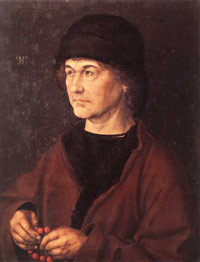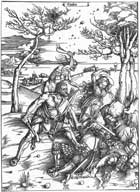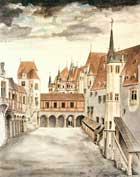Albrecht Dürer Paintings
Albrecht Dürer created paintings which added to his fame, at a time when he was already known for his woodcuts and engravings. According to F. von Schlegel, Albrecht Dürer may be called the Shakespeare of painting.
While, generally, the German painters had been influenced by the art of the Netherlands, Dürer was inspired by the Italian art. As an oil painter, he is renowned for both religious and secular subjects.

Portrait of Dürer's Father - 1490
He was influenced by the work of Jacopo de Barbari, a Venetian painter who studied the human form, and who established a workshop in Nuremberg in 1500. After establishing his own workshop, Dürer soon got the commissions. The first one, in 1496, was a very important one, the patron being Frederick the Wise, Elector of Saxony. As portraits were in high demand at that time, he commissioned his portrait, and than two altarpieces for the church of his castle in Wittenberg.
Dürer generally used the popular painting mediums of the time. Oil paintings on wooden panels were the most expensive works, and were executed usually on commission. The paintings took longer to execute, as the oil took longer to dry, and was more expensive. In Nuremberg, lime wood was the most popular. The poplar was the wood of choice in Italy, while in the Netherlands, the oak was preferred. Dürer also painted in tempera on canvas.
As it happened with many of his works, Albrecht Dürer’s paintings caused much controversy. The Venetian painters accepted him only as a graphic artist, good only in engraving, while as a painter they simply declared that he did not know how to use color. It was probably much envy in the statement, and things were settled once and for all when everybody in Venice saw the paintings of the altarpiece Dürer painted for the Guild of German merchants in Venice. All the artists had to accept that the German could paint as well as he could engrave.
Which is obvious as we look at least at his portraits. We need no further proof of his power as a painter. True, some of his works are marked by the stiff, unlovely manner of early German art. But even with these works, we should try to uncover the force of character and depth of meaning lying beyond their hard outlines.
Even these early paintings reflect the originality of his thought, and his power of expression, and they are definitely distinct from the crude productions of other German artists of his time. A good example is the Portrait of his father (1490), having a distinct character which makes it different from the usual German portraits of the period. We do not think is exaggerated to say that this painting is closer to Holbein or even Rembrandt.
The portrait already reveals a considerable level of mastering the brushes and palette, with good modelling and effective colors. The colors and the general feeling remind us more of the Venetian paintings rather than the Flemish or German masters, and is possible that at the time Dürer might have already seen works by Giovanni Bellini. At a later date, while in Venice, he had the chance to meet Bellini, whom he named the “greatest master of them all.”
What Dürer really means for the art of painting is revealed by The Four Apostles, the last and greatest of his paintings. Mastery of execution, the grandeur of thought, the depth of feeling only a philosopher mind could achieve, these words are not enough to do justice to such a noble creation.



